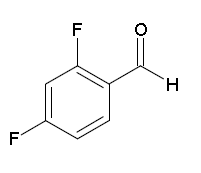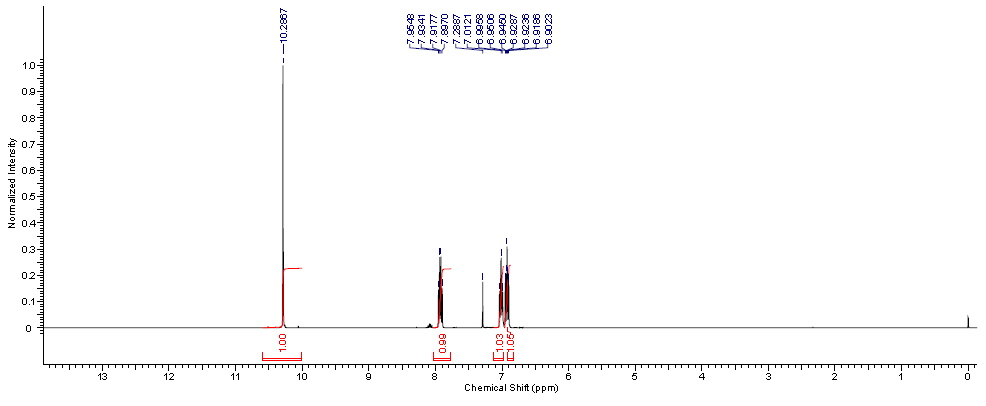2,4-Difluorobenzaldehyde CAS#: 1550-35-2; ChemWhat Code: 40082
Identification
| Product Name | 2,4-Difluorobenzaldehyde |
| IUPAC Name | 2,4-difluorobenzaldehyde |
| Molecular Structure |  |
| CAS Registry Number | 1550-35-2 |
| EINECS Number | 216-287-2 |
| MDL Number | MFCD00010326 |
| Beilstein Registry Number | 2243422 |
| Synonyms | 2,4-difluorobenzaldehyde2,4-Difluorobenzaldehyde(4-methoxyphenyl)methylamine2,4-difluoro-benzaldehyde2,6-difluoro benzaldehyde2,4-diflurobenzaldehyde2,4-DFBD |
| Molecular Formula | C7H4F2O |
| Molecular Weight | 142.103 |
| InChI | InChI=1S/C7H4F2O/c8-6-2-1-5(4-10)7(9)3-6/h1-4H |
| InChI Key | WCGPCBACLBHDCI-UHFFFAOYSA-N |
| Canonical SMILES | c1cc(c(cc1F)F)C=O |
| Patent Information | ||
| Patent ID | Title | Publication Date |
| CN113024414 | Method for efficiently synthesizing fluorine-containing compound | 2021 |
| US2013/123323 | FUNGICIDAL PYRAZOLES | 2013 |
| EP1182192 | 4-HYDROXYPIPERIDINE DERIVATIVES HAVING ANTIARRHYTHMIC EFFECT | 2002 |
Physical Data
| Appearance | Colorless to pale yellow transparent liquid |
| Solubility | No data available |
| Flash Point | 131 °F |
| Refractive index | n20/D 1.498(lit.) |
| Sensitivity | Air Sensitive |
| Melting Point, °C | Solvent (Melting Point) |
| 64 | hexane |
| 55 – 57 | ethanol |
| 62 – 63 | aq. ethanol |
| 63 – 64 | benzene, petroleum ether |
| Boiling Point, °C |
| 251 |
| 250 – 252 |
| Density, g·cm-3 | Reference Temperature, °C | Measurement Temperature, °C |
| 1.14 | 4 | 25 |
| 1.2 | 4 | -190 |
| 1.24 |
| Description (Association (MCS)) | Solvent (Association (MCS)) | Temperature (Association (MCS)), °C | Partner (Association (MCS)) |
| Stability constant of the complex with … | CCl4 | 24.9 | 4-Fluorophenol |
| Stability constant of the complex with … | aq. HNO3 | 25 | AgNO3 |
| Enthalpy of association | acetonitrile | 25 | iodine |
| NMR spectrum of the complex | CDCl3 | Cu(2,4-dichloro-benzoate)2 |
Spectra
| Description (NMR Spectroscopy) | Nucleus (NMR Spectroscopy) | Solvents (NMR Spectroscopy) | Frequency (NMR Spectroscopy), MHz |
| Chemical shifts, Spectrum | 1H | chloroform-d1 | 400 |
| Chemical shifts, Spectrum | 13C | chloroform-d1 | 101 |
| Chemical shifts | 1H | dimethylsulfoxide-d6 | |
| Chemical shifts | 19F | neat (no solvent) |
| Description (IR Spectroscopy) | Solvent (IR Spectroscopy) | Comment (IR Spectroscopy) |
| Bands | potassium bromide | |
| FT-IR-Difference Spectroscopy, Bands, Spectrum | ||
| Bands, Spectrum | ||
| Bands | 1710 cm**(-1) | |
| Bands | nujol | 1699 cm**(-1) |
| Description (Mass Spectrometry) |
| gas chromatography mass spectrometry (GCMS), spectrum |
| liquid chromatography mass spectrometry (LCMS), spectrum |
| high resolution mass spectrometry (HRMS), electron impact (EI), time-of-flight mass spectra (TOFMS), spectrum |
| Description (UV/VIS Spectroscopy) | Solvent (UV/VIS Spectroscopy) | Comment (UV/VIS Spectroscopy) |
| Spectrum | gas | 220 – 250 nm |
Route of Synthesis (ROS)
| Conditions | Yield |
| With sodium tetrahydroborate In methanol at 0℃; Inert atmosphere; | 100% |
| Stage #1: 2,4-difluorobenzaldehyde With C36H44F4N2Ni2P2; diphenylsilane In tetrahydrofuran at 45℃; for 3h; Schlenk technique; Inert atmosphere; Stage #2: With sodium hydroxide In tetrahydrofuran; methanol at 60℃; for 24h; Schlenk technique; Inert atmosphere; | 99% |
| With methanol; sodium tetrahydroborate at 0℃; for 1h; | 88% |
Safety and Hazards
| Pictogram(s) |   |
| Signal | Warning |
| GHS Hazard Statements | H226 (100%): Flammable liquid and vapor [Warning Flammable liquids] H315 (100%): Causes skin irritation [Warning Skin corrosion/irritation] H319 (100%): Causes serious eye irritation [Warning Serious eye damage/eye irritation] H335 (97.87%): May cause respiratory irritation [Warning Specific target organ toxicity, single exposure; Respiratory tract irritation] Information may vary between notifications depending on impurities, additives, and other factors. |
| Precautionary Statement Codes | P210, P233, P240, P241, P242, P243, P261, P264, P271, P280, P302+P352, P303+P361+P353, P304+P340, P305+P351+P338, P312, P321, P332+P313, P337+P313, P362, P370+P378, P403+P233, P403+P235, P405, and P501 (The corresponding statement to each P-code can be found at the GHS Classification page.) |
Other Data
| Transportation | NONH for all modes of transport |
| Under the room temperature and away from light | |
| HS Code | 29130000 |
| Storage | Keep away from heat, sparks, and flame. Keep away from sources of ignition. Store in a tightly closed container. Store in a cool, dry, well-ventilated area away from incompatible substances. Do not expose to air. Store under an inert atmosphere |
| Shelf Life | 2 years |
| Market Price | USD |
| Druglikeness | |
| Lipinski rules component | |
| Molecular Weight | 142.105 |
| logP | 2.04 |
| HBA | 1 |
| HBD | 0 |
| Matching Lipinski Rules | 4 |
| Veber rules component | |
| Polar Surface Area (PSA) | 17.07 |
| Rotatable Bond (RotB) | 1 |
| Matching Veber Rules | 2 |
| Use Pattern |
| 2,4-Difluorobenzaldehyde CAS#: 1550-35-2 used as an intermediate for medicines |
| 2,4-Difluorobenzaldehyde CAS#: 1550-35-2 used as an intermediate for pesticides |
| 2,4-Difluorobenzaldehyde CAS#: 1550-35-2 used as an intermediate for liquid crystal materials. |
Buy Reagent | |
| No reagent supplier? | Send quick inquiry to ChemWhat |
| Want to be listed here as a reagent supplier? (Paid service) | Click here to contact ChemWhat |
Approved Manufacturers | |
| Caming Pharmaceutical Ltd | http://www.caming.com/ |
| Want to be listed as an approved manufacturer (Requires approvement)? | Please download and fill out this form and send back to approved-manufacturers@chemwhat.com |
Contact Us for Other Help | |
| Contact us for other information or services | Click here to contact ChemWhat |


